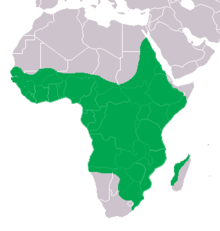Nile crocodile
| Nile crocodile Temporal range: 2.5–0 Ma Early – Recent |
|
|---|---|
 |
|
| Nile crocodile in Gulu, Uganda | |
| Scientific classification | |
| Kingdom: | Animalia |
| Phylum: | Chordata |
| Class: | Reptilia |
| Order: | Crocodilia |
| Family: | Crocodylidae |
| Subfamily: | Crocodylinae |
| Genus: | Crocodylus |
| Species: | C. niloticus |
| Binomial name | |
|
Crocodylus niloticus Laurenti, 1768 |
|
 |
|
| Range map from before the West African crocodile was considered separate | |
| Synonyms | |
|
|
The Nile crocodile (Crocodylus niloticus) is an African crocodile and may be considered the second largest extant reptile in the world, after the saltwater crocodile (Crocodylus porosus). The Nile crocodile is quite widespread throughout Sub-Saharan Africa, occurring mostly in the central, eastern, and southern regions of the continent and lives in different types of aquatic environments such as lakes, rivers and marshlands. Although capable of living in saline environments, this species is rarely found in saltwater, but occasionally inhabits deltas and brackish lakes. The range of this species once stretched northward throughout the Nile, as far north as the Nile delta. On average, the adult male Nile crocodile is between 3.5 and 5 m (11 ft 6 in and 16 ft 5 in) in length and weighs 225 to 750 kg (496 to 1,653 lb). However, specimens exceeding 6.1 m (20 ft 0 in) in length and weighing up to 1,090 kg (2,400 lb) have been recorded.Sexual dimorphism is prevalent, and females are usually about 30% smaller than males. They have thick scaly skin that is heavily armored.
The Nile crocodile is an opportunistic apex predator and a very aggressive species of crocodile that is capable of taking almost any animal within its range. They are generalists, taking a variety of prey. Their diet consists mostly of different species of fish, reptiles, birds and mammals. The Nile crocodile is an ambush predator that can wait for hours, days and even weeks for the suitable moment to attack. They are quite agile predators and wait for the opportunity for a prey item to come well within attack range. Even swift prey are not immune to attack. Like other crocodiles, Nile crocodiles have an extremely powerful bite that is unique amongst all animals and sharp conical teeth that sink into flesh allowing for a grip that is almost impossible to loosen. They can apply high levels of force for extended periods of time, a great advantage for holding down large prey underwater to drown.
...
Wikipedia

